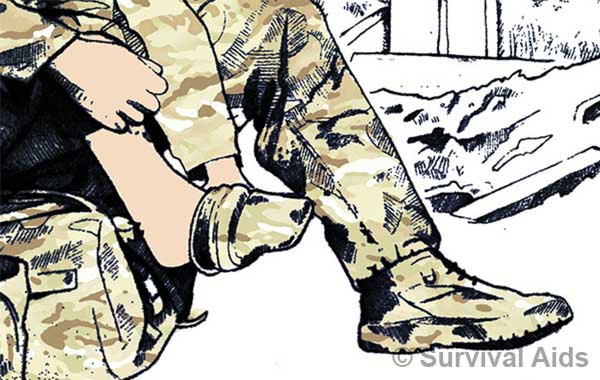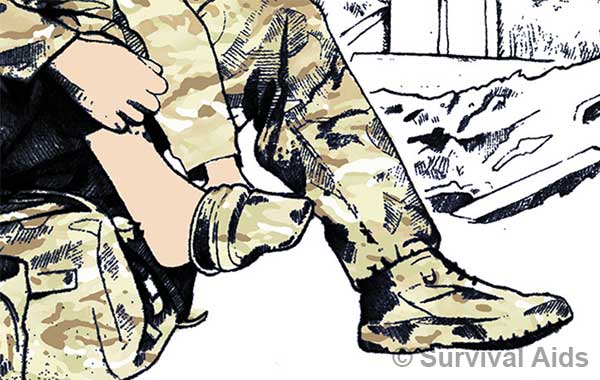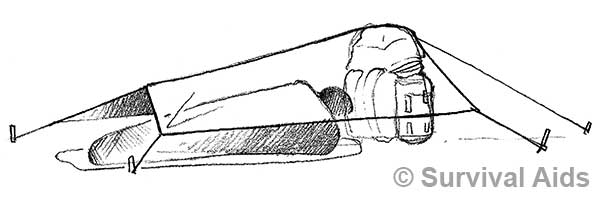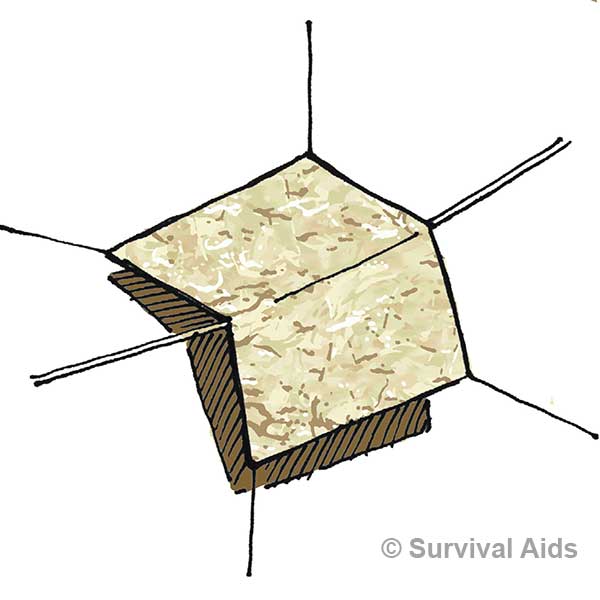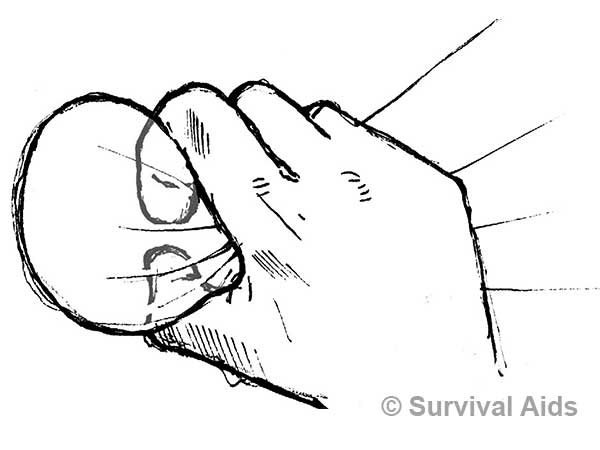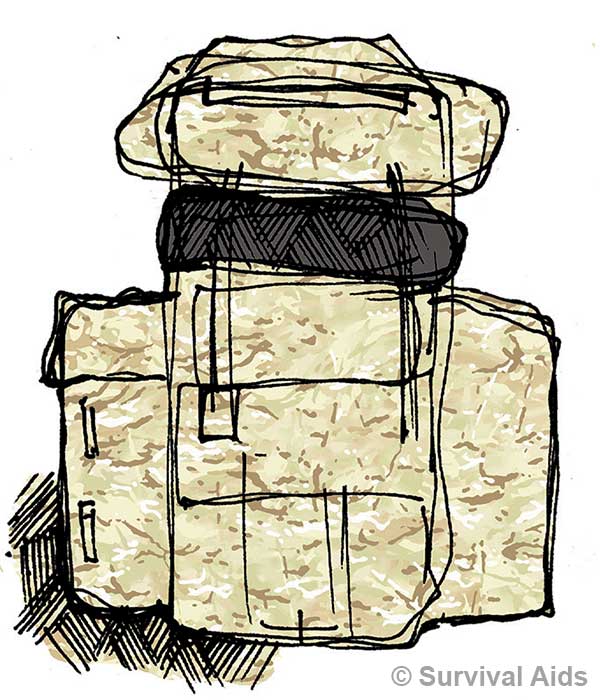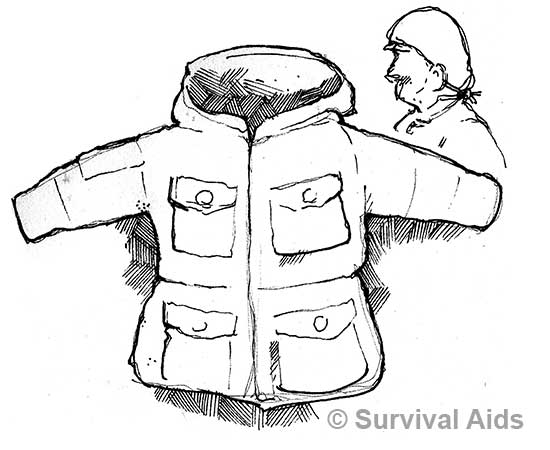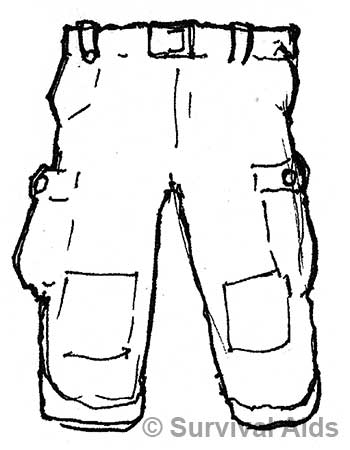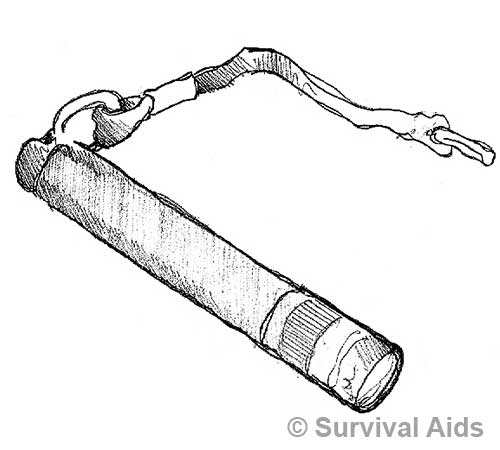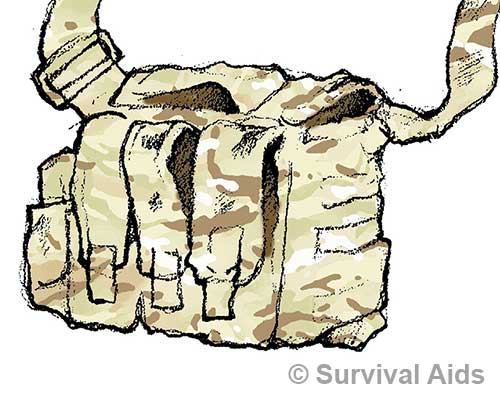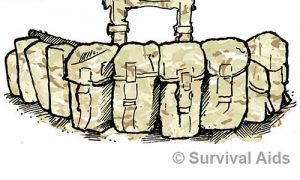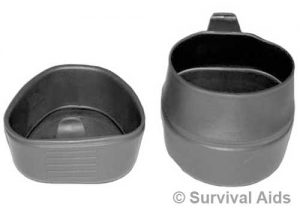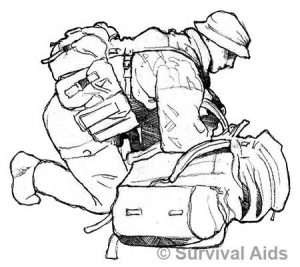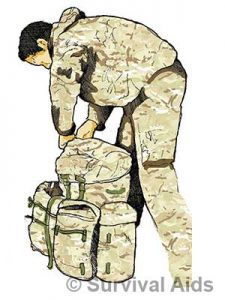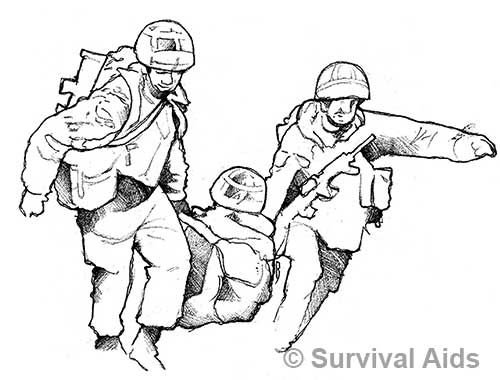IN THE FIELD
For all the technology at the military’s disposal, now or in the future, there will still be soldiers on the ground, living out of bergens.
Living out of a bergen for long periods can wear you down and arduous training, insufficient rest and the same rations, all takes their toll. Therefore learning essential skills for fieldcraft and the equipment needed will help you feel more prepared.
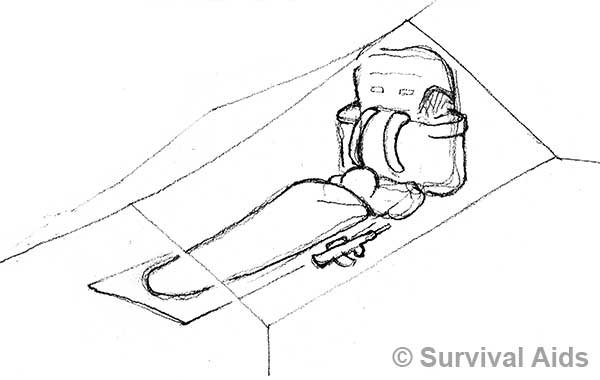
British army weapons
It is like any other military skill, you get better practice, you don’t need mountains of kit, use what you have sensibly, improvise, learn from others, and have multiple uses for things.
MULTIPLE USES
Most things you carry, can have two or three uses, it pays to experiment, being wet and uncomfortable won’t kill you, you shouldn’t fear it. It doesn’t hurt to be uncomfortable occasionally, we’re constantly learning and a bit of clever kit prep can sort it out.
Your bergen contains much of your kit, sit on it when you stop for a breather, use it as a windbreak at one end when you’re in your basha, in open ground take cover behind it. Grab the patrols bergens together to form a raft for a river crossing or take a casualty across a river. That one simple item has numerous uses if you use your imagination. Take this approach with all you kit, cut down on all the useless junk that people cart around for no reason.
Before you pack your bergen check all the clips, zips and buckles, they can break with careless use and make carriage extremely uncomfortable. Reinforce the attachments on your bergen with doubled up para cord loops, eg: where the shoulder straps attach to the main body, these straps can fray and break. Place a network of bungees on the back of your Bergen, for attaching items such as your helmet, you can get nets with clips as well which are sturdy and very useful.
“Use what you have sensibly, improvise”
Cable ties have multiple uses, you can get them from any hardware store, they make good improvised handcuffs for detainee handling, securing kit to wagons, tethering masts, constructing OPs along with numerous first aid, applications. They can be released and reused again by applying a point of a pen knife or pencil/pen to the teeth. Loop a few into your belt kit or ops vest. You never know when you might need them.
Wrap your lighter in masking tape, useful for making emergency repairs to kit, and in an emergency you can screw it up in a ball and it’ll burn for up to 30 mins, which will provide a useful light source, but make sure the areas well ventilated.
“if your not using it in the next 30 seconds, stow it away”
Your bivvy bag, as well as keeping your sleeping bag dry, can be used as a survival shelter in extreme temps. Take a small tin with a honeycomb of cardboard impregnated with candle wax, light this, sit cross legged over it, placing your bivvy bag over your head/body and it will provide warmth well beyond its size and weight. The flame can be extinguished by popping the top back on, and for an hour or so until it cools down makes a great hand warmer.
Have a spoon in your pocket, one in your belt kit, and one in your Bergen, they weigh nothing but forgetting it is common and a pain.
Check your compass before you deploy, if it’s got a bubble in it, exchange it, if the Q bloke tells you to do one, then swap it with your locker one. You should always have a spare in your bergen in your admin pouch.
GLOVES
Our hands take a real hammering when we’re in the field, after a few days the skin cracks and infection gets in. In places like Afghan where sanitation in poor, dust can be largely made up of dried human excrement. You really don’t want that in your blood stream. Carrying out searches and rummaging can lead to sharps injuries, so always wear gloves, and don’t cut the fingers off, they are there for a reason. Protect yourself.
CHANGING SOCKS
Change them one foot at a time, boot off, wet sock away, dry and powder foot, dry sock on (goretex sock on if you’re static for a period, but remember to remove them when you resume the patrol) boot on, lace up, if you’re bumped you only have to pop one boot on and scarper. You should have your boots on in your doss bag, pop sand bags over them to keep it clean inside, clean mud and leaves off before you get in.
WOOLLY HAT AND GLOVES
Keep a spare set of woolly hat and gloves in your admin bag, they are instant morale, when you’re static put your dry on, try and dry out your wet. Then put your wet back on and stow your dry, it’s hard to do when it’s gibbering, but you’ll degrade if you allow all your kit to get drenched, you won’t last long.
WET/DRY DRILLS
This is one of the most unpleasant things in training, but if you can keep a set of dry kit in your bergen, you can operate for long periods. If your dry kit is wet through, then it can be a drain on morale carting it around.
Before you get into your doss bag, get carefully into your dry kit, make sure you don’t get it wet. Place your wet kit under your bivi bag, as this is where most of your body heat will be transferred.
Soldiers Kit socks
Dry your wet socks by ringing them out and placing them inside your trousers with the tops hooked over your belt, powder and dry your feet before you put dry socks on. If you have them put gortex socks on then put your boots on, clean the mud/leaves off your boots, then place each one in a sand bag, you should always have your boots on in your bag, unless told otherwise.
IN YOUR BASHA
A good item to invest in if you’re hell bent on spending your own money is a good basha they’re not expensive and you can get a decent sized one this is a really useful idea and can mean that you don’t have to splash out on an expensive tent, however a tent is a must if you’re planning a long stay out of doors, it’s called emergency basha for a reason.
Emergency Basha
Always make the effort to sling a basha up, not doing so is just lazy, it might not be raining when you get your head down, but it’s rubbish waking up in the rain, your mates are tucked up, snoring contentedly, and you’ve got to get out “in the rain” and put one up. But there’s always the option to put one up between two.
There are two types of bashas, good ones that keep you dry, and rubbish ones that flap (noisily) and leak. Take an extra 5 mins to put up a good one, if you’re a student of the school of “if you can’t do knots, do lots” this won’t help you in the cold dark morning when you have to take the bloody thing down, and can’t undo them. You might be tempted to just snap it and deal with it later, but you’ll be leaving signs and you’re shortening your basha strings each time. Bungees are commonly used but take care, a bungee in wet tired fingers, can slip free and take an eye out, and your mum gave you them and she only gave you two.
BASHA STRINGS
Chances are you’ll have to erect your basha at night, so be prepared, throw a few up in day light and then do it one evening in the dark, or just close your eyes and feel your way. Time spent doing this now will save you valuable zzzzz time when you most need it.
Basha Strings
Loop string to all the brass eyelets, if you use two different types of string with different textures A for the roof and B for the corners (see diagram) you’ll know in the dark what goes where.
Things tend to miraculously expand after a few days in the field, so be realistic, don’t pack everything in so tight that you can’t get anything else in. If a mate goes down, you may have to share some of his equipment amongst you to lighten his load for a day or two.
Basha Strings Fieldcraft
Clean your equipment as best as you can before you pack it away, it always takes longer than you think to pack away your kit, so get up 10 mins early, and pack it as you hope to find it at the end of the day. Brush off all the twigs, leaves, mud and roll your basha up nice and neat, don't just stuff it in.
LIVING IN YOUR BASHA
Use your bergen as a windbreak at the head end, belt kit as a pillow, in a bivi bag you can shuffle down so your feet are outside to make some room for admin, then when you’re done shuffle back undercover. You won’t get much choice where you put your basha, you’ll be placed in an area with an arc to cover, make the best of the spot you’ve got, make a sweep of your real estate.
Ponchos can be used as improvised stretchers but it’s not easy, it’s hard to maintain a grip when you’re carrying a casualty, tying a ball of rags/grass or stuff and slipping a cable tie around it will create a toggle that you can grab onto without it slipping out of sweaty fingers. It’s advisable to carry a proper collapsible stretcher, but a poncho can be pressed into service. This technique is ideal if you’re moving spoil from an OP or other stuff.
Poncho Grip Fieldcraft
PACKING YOUR BERGEN
Units may have a standard method for packing bergens, your bergen is essentially your home and should be organised in a straight forward way, the way I like to differentiate it is that main compartment is mine and everything else is the Army’s. There’s a more detailed look at this later.
Pack Your Bergen
GRAB BAG
At the top of your bergen beneath your top flap lives your grab bag, so named that you “grab it” if you (a) have to leave your bergen behind if compromised and are on your toes (b) have pre-packed it for a specific task and will return to your bergen later.
Grab bags contain mission essential equipment, the signaller will stow his radio, ancills, batteries here, as will the medic, dems man etc.. For the rest of us it can be used to extend our durability. We can live off our belt kit for 24hrs, with a grab bag on our backs, containing warm kit, goretex top, another 24hrs rations, other patrol kit, ammunition, knee pads, we can go on a bit longer.
SMOCK AND TROUSERS
Windproof Smock
Windproof Smock:
- All buttons taped up with sniper tape
- Hold Whistle
- Holds Your Compass, notebook and cam cream
- Replace cord with bungee
- A small torch, head torch, lighter, matches in other pocktets
- Don’t cut off the hood drawcord, use the Swedish hood method
Windproof Trousers
Windproof Trousers:
- Invest in a decent riggers belt
- Carry spare buttons in your housewife, but double stitching all your buttons will ensure they don't pop off
- Maps on lanyard
- Even with kneepads, trousers wear away at the knee, sew an extra double thickness layer for a bit of extra durability.
- Velcro fasteners on your pockets stop things falling out
- Med kit, have all in a bag with a drawcord, rather than loose, if you need to you can chuck it to someone who needs it.
- Pre-sew elastics into your ankles
Map Reading Torch replace the cord with bungee, always have it attached to your smock, red light is no good for map reading, it masks the contour lines. Maintain light discipline by taping up the front with sniper tape and making a small pin-prick hole, practice this technique.
Torch Light Field Craft
ADMIN BAG
When the Section Commander has sorted out all the stags, it’s time to administer yourself, battle clean your weapon, get a brew on have some scoff, dry socks etc...
Just under your grab bag, on top of your main compartment lives another smaller shoulder bag, your admin bag, whip this out sling it over your shoulder, so if you have to run it’s coming with you.
Admin Bag MTP
In here you’ll find your stove, fuel, food, spare laces and lighter, your personal med. kit (for small wound repair, wet wipes, antiseptic cream, plasters, head ache tablets, anti-inflammatory pills, tiger balm etc.) spare batteries for your torch, spare compass (your maps will be either in your hip pocket, or in the top flap of your bergen), spare woolly hat and gloves, foot powder.
The only thing on the floor should be cooker, which will be lost if you have to leg it in a hurry.
BELT KIT
Your unit SOP’s will dictate what you carry in your belt and each mission will mean changes, this is an example of the sort of common rig that you can build on.
Belt Kit Fieldcraft
Using your belt kit as a pillow aids a good nights kip, and it’ll be to hand if/when you get bumped, other useful things to have on you, secateurs, folding saw, speed loader, spare muzzle covers, knife.
Your belt kit can hold -
- Comms cord in pouch, on fishing reel type spool
- Velcro mag pouches 3 x mags each (mags at the rear can sometimes be difficult to get out in the prone)
- Water bottle
- Survival pouch, metal mug, lighter tin, candle, brew kit, hexi, 3 x nails, 24 hr rations, heli marker panel
- Med pouch
- Smoke
- Grenades
SCOFF / RATS / SCRAN
The same food day after day can be dull, and get on your nerves, anything you can do to improve it is worth a little extra weight. Tobasco sauce, curry powder, sticky bars can all be a little bit of home or change a dull meal into something different. And “change is as good as a rest” they say.
The Swedes have got paring their kit down to the bare essentials, down to a fine art, invented in Sweden the folding mug weighs a few grams, it folds down to half its size when not in use, and is pretty solid when full. Keep one in your smock pocket.
Swedish folding mug
HEAD TORCHES
A great bit of kit, but they should be used only in an area where you’re far from the enemy, you can sometimes forget that it’s on your head, and you shouldn’t rely on it, know your Bergen and belt kit inside and out, a soldier emptying his kit all over the floor looking for one small item is a pitiful sight.
CAMEL BACKS
Cleaned out and sterilise every so often, leaving them with a little water in them for months in your locker and them pressing them straight into service can make you very ill, a friend of mine trained months for a race, and on the day used a camel back from his locker, he lasted an hour having to retire from the race with a very bad tummy!!!! What a waste of effort.
SWEDISH HOOD
Putting the hood of your smock completely up will impair your peripheral vision, and affect your hearing, put it up only in rear areas. The Swedish military who have to tackle harsh winter temperatures are experts in retaining all body heat. And have a method of using the hood.
DROPPING YOUR BERGEN
Drop down on one knee and carefully lay it down, this will prevent you from making a noise and protect mission-essential equipment. When moving off, place your weapon on the floor use both arms to get your bergen on, or get your mate to help you on with it.
Bergen drop off
REMAIN TACTICALLY AWARE
Remember when placing your weapon on the floor never to move away more than arms reach from it, place it with the cocking handle uppermost, keep the muzzle out of the dirt and ensure that dust cover’s closed.
Bergen inside the main compartment you’ll have a large canoe bag, this only needs to be folded over, it will keep dry. Seal it shut when you immerse your bergen on a river crossing. Constantly opening and shutting it makes a distinctive snapping noise which carries.
- Spare maps water-proofed, needle and thread
- Grab bag mission essential eqpt
- Camel back water bladder
- 4 x Karabiners 2 each side for bergen raft
- Admin bag food, rubbish bag, brew kit etc...
- Bivi bag with your doss bag wrapped in it for added protection, you could also leave your foot kit in here, and a pair of trainers, in case you get the opportunity to get out of your boots for a bit.
Admin - Spare clothes in a canoe bag - done up, it’s at the bottom of your bergen as you’ll only access it when you’re either in a harbour area or in relative safety
PUTTING ON YOUR GORETEX
When it rains don’t rush to get your Goretex on, if it’s only a small shower it’ll pass and the sun and wind will dry your kit out naturally, the beauty of mother nature eh? However, if it’s a determined downpour and black clouds looming then stop and put it on. Don’t put your hood up unless you’re safely in a harbour area and somebody is watching on stag, the hood will cut down your peripheral vision. Always keep your top handy and packed above the bottoms, 9 times out of 10 you’ll not need your bottoms, they make for uncomfortable going and are not good for tabbing in, they’re a bad when crossing fences. Goretex top and bottoms are really handy is river crossing, stow all your dry kit in your Bergen and do the crossing in your top and bottoms.
Bergen packing field craft
KIP MAT
There are many types of kip mat, at the end of the day it’s just something to lie/sit on. Inflatable ones get punctured, regardless of what the manufacturers say, and who can be bothered to repair it in the field, or even when you get home, when you know that its only a matter of time before it’ll go again? If you’re hell bent on not carrying the issue one (which is perfectly good) buy a simple folding one, if you are going to trim the issue one down, ensure that it’s at least the length of your torso. By chopping it down you are not saving much space in your Bergen, and no weight gain. Stow in under your top flap, so it’s easily retrievable, makes a comfy seat.
Also keep a small folded bit of kip mat handy, about twice the size of an A4 sheet of paper, tucked in your Bergen somewhere to hand, it weighs nothing, use it to stand on when you’re changing into your wet/dry kit, sit on it. Mark out on your kip mat the outline of a neck brace and sam splint, so that you can cut it out with your leather man, it’s not as good as the real thing, but it’s a good alternative.
Man down drill
COOKING IN THE FIELD
Chose one that doesn’t hiss, the advantage of gas is that you can modify it, so that it won’t give off too much light, gas doesn’t work so well when it’s really cold. Jet boilers are very good, expensive but need to be looked after, if you have it in your side pouch and your Bergen and it gets slung off a four tonner (it won’t bounce!!).
KNIVES AND BLADES
Be sensible when spending your own money they are expensive you only need a basic knife, a lightweight Leatherman type is ideal, keep it oiled and rust free. A folding saw is also a good buy, don’t forget that knives do break in the cold, and of course be very careful when handling knives.
GOLOKS AND PARANGS
Used for clearing scrub and undergrowth, they come with a lanyard to attach to your wrist. This is not for show. If you trip your natural instinct is to grip with your hand and if you fall on it, you will run the length of the blade along the inside of your four fingers to the bone. Don’t let it happen to you.
HARD ROUTINE
When you are close to the enemy, or in an area where it’s not possible to cook (the sounds, smells and light of cooking carries far and can give you away) cold food is better than nothing, some people can’t keep cold food down, it’s better to find this out in training. You can warm boil in the bags up a bit by keeping them next to your skin, either when your in your bag or tabbing. If you’re vehicle borne utilise the heat from the engine block, lift the bonnet as soon as you stop, but be mindful of where you place them, and don’t burn your hands.
By the same token you can also keep water cool, if your bergen strapped to the side of your wagon by wrapping it in a damp cloth, the wind will cool it down.
EAT BEFORE YOU FIGHT
Soldiers in the Arctic eat before a march, it’s an essential drill for working and fighting in the extreme cold, this is a good maxim to observe when training, or on operations anywhere.
Don’t see food as a reward or a carrot after exertion, it’s putting fuel in the tank and should be done before you set out on a task. Keeping a little bag of pre-broken up food in your smock pocket (in a non-rustling bag) will mean you can dip into it in lulls in play, keeping yourself fuelled up and ready for the “GO”.
MOSQUITO KIT
Mosquito repellent and mosi head nets, are an absolute must, like spoons keep one in your pocket and a spare one in your belt kit. They weigh nothing but anyone who has spent a sleepless night getting eaten alive and driven mad by midgies will agree that they are worth their weight in gold (the head nets not the midgies).
That just about wraps up this section, you guys are always coming up with novel ways to make life easier in the field, so if you have any bright ideas that you’ve come up with then email them to us, and we can hopefully include them and pass on best practice.




